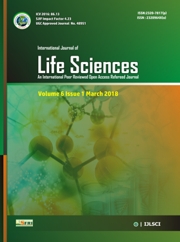RESEARCH ARTICLES
Volume 7 |Issue 6| November-December 2019 First published: 30 December 2019
Application of Nanotechnology in Insect Pest Management
Rashmi Urkude
Department of Chemistry, Shri Shivaji Science College, Nagpur-440012, India
Abstract
Keywords: Nanopesticides, Nanotechnology, Insect pest, Bioefficacy.
Editor: Dr.Arvind Chavhan
Cite this article as:
Urkude Rashmi. Application of
Nanotechnology in Insect Pest Management,
Int. Res. Journal of Science & Engineering,
2019, 7 (6): 151-156.
References
1. Massinon M, Cock ND, Forster WA, Nairn JJ, Mccue SW, Zabkiewic JA, Lebeau F. Spray droplet impaction outcomes for different plant species and spray formulations. Crop Prot., (2017);99: 65-75.
2. Pandey S, Giri K, Kumar R, Mishra G, Rishi RR. Nanopesticides: opportunities in crop protection and associated environmental risks. Proc. Natl. Acad. Sci. India, (2016); 1-22.
3. Barik TK, Sahu B, Swain V. Nano-silica from medicine to pest control. J. Parlog. Res., (2008). 103(1): 253–258.
4. Panpatte DG, JhalaYK, Shelat HN,Vyas RV. Nanoparticles: The next generation technology for sustainable agriculture. In Microbial Inoculants in Sustainable Agricultural Productivity; Springer: New Delhi, (2016); 289-300.
5. Shojaei TR, Salleh MAM, Tabatabaei M, Mobli H, Aghbashlo M, Rashid SA, Tan T. Applications of nanotechnology and carbon nanoparticles in agriculture." Synthesis, Technology and Applications of Carbon Nanomaterials; Suraya A. R., Raja N. I. R. O., Mohd Z. H., Eds.; Elsevier, Amsterdam, Netherlands, (2019) ; 247-277.
6. Elek N, Hoffman R, Raviv U, Resh R, Ishaaya I, Magdassi S. Novaluron nanoparticles: Formation and potential use in controlling agricultural insect pests. Colloids and Surfaces A: Physicochemical and Engineering Aspects, (2010); 372(1-3):66–72.
7. Ao M, Zhu Y, He S, Li D, Li P, Li J, Cao Y. Preparation and characterization of 1-naphthylacetic acid-silica conjugated nanospheres for enhancement of controlled-release performance. Nanotechnology, 2013; 24: 035601.
8. Ghormade V, Deshpande MV, Paknikar KM. Perspectives for nano-biotechnology enabled protection and nutrition of plants. Biotechnol. Adv.,(2011); 29:792–803.
9. John H, Lucas J. Clare W, Dusan L. Nanopesticides: a review of current research and perspectives. New Pestic. Soil Sens., (2017): 193-225.
10. Anjali CH, SharmaY, Mukherjee A, Chandrasekaran N. Neem oil (Azadirachta indica) nanoemulsion - a potent larvicidal agent against Culex quinquefasciatus. Pest Manag. Sci., 2012; 68:158−163
11. Yu M, Yao J, Liang J, Zeng Z, Cui B, Zhao X, Sun C,Wang Y, Liu G, Cui H. Development of functionalized abamectin poly(lactic acid) nanoparticles with regulatable adhesion to enhance foliar retention. RSC Adv., (2017); 7: 11271- 11280.
12. Hack B, Egger H, Uhlemann J, Henriet M, Wirth W, Vermeer AWP, Duff DG. Advanced Agrochemical Formulations through Encapsulation Strategies.Chem. Ing. Tech.,(2012);84: 223-234.

